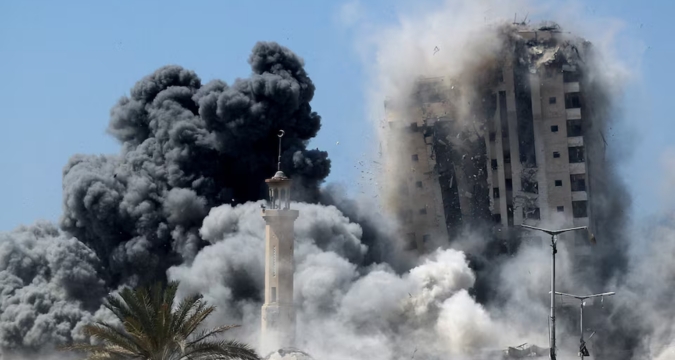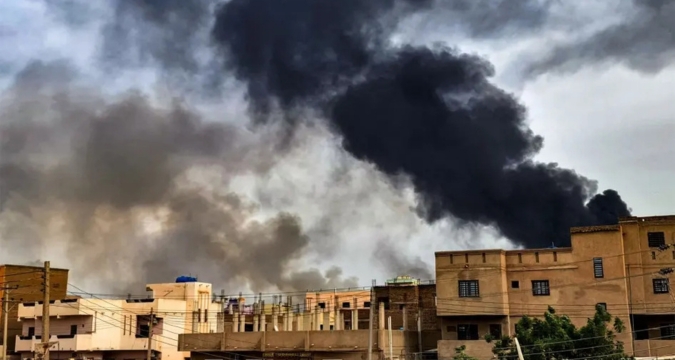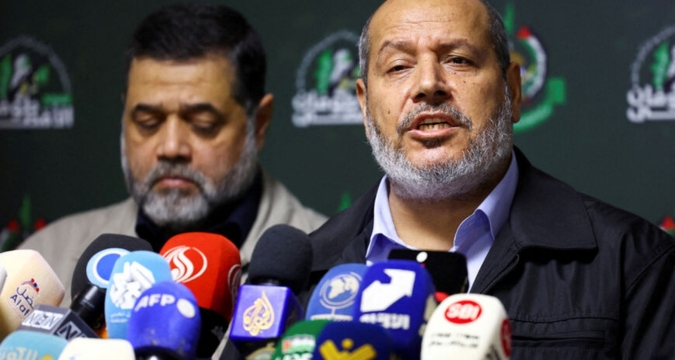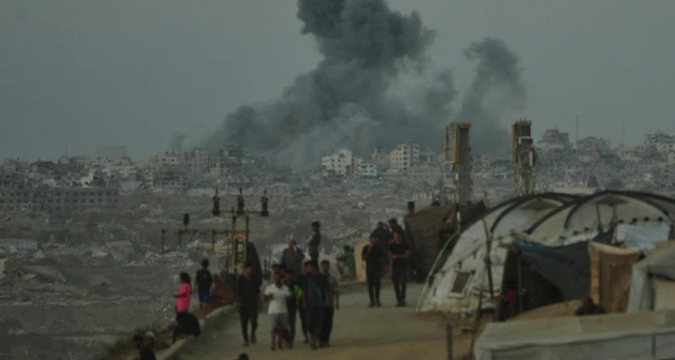A Deep-Dive Analysis by The Vue Times
On October 6, 2025, Hamas and Israel delegations started indirect peace negotiations in Sharm el-Sheikh, Egypt, which is the first serious diplomatic effort to end the Gaza War in nearly two years. The negotiations are referred to as the Gaza Peace Plan of the Trump Administration, which implies a staggered structure to cease hostilities and ensure hostages, consequently embarking on mass reconstruction of the ruined land.

This renewed negotiation is followed by the second anniversary of the October 7, 2023, onslaught of Hamas on Israel is one that has brought about a full scale war and left Gaza in shambles and regional politics in shades of black and white ever since.
An Overview Of How We Came To Be Here
- October 7, 2023: Hamas militants coordinated a massive, cross-border assault into the southern part of Israel killing approximately 1,200 Israelis and taking hundreds of people as hostages. It marked the beginning of the great military campaign in Gaza undertaken by Israel.
- 2024-2025: The war was fought in stages of violent conflicts and periodic ceasefire and hostages exchange talks. Big portions of urban facilities in Gaza were ruined; humanitarian indicators worsened drastically. The exchanges and ceasefires were mediated by international actors, such as Egypt, Qatar and different western capitals, intermittently.
- September 2025: The United States presented a three-step, 20-point or 21-point plan, which connects a Turkish, fast protocol with hostages and a prisoner swap to an armistice, the gradual settlement of Israeli troops, a no-armistice disarmament of Hamas and a new fabric of transitional government and rebuilding designed internationally. Hamas was indicated as conditional acceptance of significant aspects, and Washington harassed to transform the opening into direct technical discussions in Cairo.
- October 6, 2025: Indirect discussions were initiated in Sharm el-Sheikh where mediators are running back-and-forth across the two. Special envoys of the United States such as Steve Witkoff and Jared Kushner were said to be in town finalizing the technicalities. The international media reacted. An initial report by the Egyptian state-owned media and intermediaries outlined the first day going on in an affirmative environment.
Data Snapshot: Gaza’s Reconstruction Cost (Projected 2025–2030)
| Sector | Estimated Damage (USD) | Recovery Timeline |
| Housing and Urban Infrastructure | $9.5 billion | 5 years |
| Energy and Power | $3.2 billion | 3 years |
| Water and Sanitation | $2.4 billion | 4 years |
| Education and Healthcare | $4.1 billion | 6 years |
| Economic Rehabilitation (SMEs, Agriculture) | $5.8 billion | 7 years |
| Total Estimated Reconstruction Cost | $25 billion | 5–7 years |
International donors, led by the EU, Japan, and Gulf states, have pledged to support rebuilding, contingent on a lasting ceasefire and transparent governance in Gaza.
The Main Aspects of the Trump Plan in Short

According to reporting throughout with the key outlets, the following key elements can be listed as the foundation upon which the U.S. proposal is based:
- First stage in the short term: An emergency hostage-prisoner swap and a negotiated ceasefire. According to the press reports, there was a formula upon which Hamas would release the rest of the hostages, alive or not, in exchange for mass release of Palestinian prisoners – numbers mentioned in the published coverage include 250 of prisoners under life sentence, plus about 1700 Palestinian detainees captured since October 7, 2023. Other iterations of the plan have very rigid schedules of the preliminary exchanges, with a window of 72 hours of finalization down to the first releases.
- Security/demilitarization: A second step involved eliminating Hamas offensive capacity, specifically; destroying rockets, tunnels and command centers, and offers different options on whether this is through political or with force. Israel considers disarmament to be non-negotiable; Hamas considers this to be existential.
- Administrative transition: Suggestions to succeed the Hamas rule in Gaza with a technocratic or internationally monitored government with a specific time frame to carry out reconstruction and Dodge reco-equipment. It is one of the most politically-connoted aspects of the plan.
- Reconstruction and Assistance Canals: Test rising of humanitarian access, reconstruction commitments and reopening’s of crossings – needs worldwide donor arrangement and assurances on control. Key roles would be played by Egypt, UN and the donor states.
Who Speaks, Who is in the Room?
The negotiations are indirect in that the Israeli and the Hamas negotiators do not have a face to face period. Envoy and mediators inject poses and offers between rooms. The following are reported to be the key actors:

- Hamas: It was headed by the most senior leaders such as Khalil al-Hayya, who reformed in Cairo after being struck by Israeli campaign in Doha in September, causing the demise of several of his companions and kin. His presence accorded Hamas both negotiating weight and assurance in the public.
- Israel: Technocratic departments and political delegations, including the offices of the Prime Minister and ministries of the government dealing with security and hostages, including Strategic Affairs. There has been a public Israeli announcement of conditional support of the U.S. roadmap by Israeli political leaders who are experiencing hardline domestic opposition.
- Mediators: key players on the ground are Egypt and Qatar. Special Envoy Steve Witkoff and Jared Kushner are being seen as the faces of negotiation although it is the United States that is offering the plan and exerting high-level pressure. The international organization, like the ICRC, is supposed to help verify the exchange and remnants management.
The Politics of Humanitarian Arithmetic
Ergonomics makes the human cost fundamental to the urgency and limits changes in politics. Unexamined official Gaza health-ministry and UN coverage puts death and injuries in dramatic historical context. United Nations Humanitarian briefs and Gaza health ministry counts have continued to record tens of thousands of Palestinian deaths since October 2023 and widespread displacement, and basic services are almost collapsing. The report by relief agencies documents acute lack of water and electricity, shelter and medical facilities despite hostilities being witnessed.
Simultaneously, the October 7, 2023 attack and the question of hostages are among the main political sources of change within Israel. To the Israelis the hostages are the non-negotiable human element that should be provided by a deal and to Palestinians the quantity of civilian casualties and who will be in charge of Gaza is how much can be afforded by a deal. The mix compromises are countered by politics at a price on either side.
The Sticking Points – The Hardness of a Deal
Based on reporting and proven statements the negotiators need to fill at least five fundamental gaps:
- Survival versus disarmament: Hamas has to be disarmed by Israel. Hamas considers guns as its sole insulation against future invasion and as part of internal vanity. Converting disarmament into non-violent and enforceable language is very challenging.
- So who governs Gaza next International or technocratic interim government Proposals: The creation of outside authority provokes political opposition of Palestinian forces and most of Arab populations who distrust foreign governance. Egypt and Qatar fear any deals that would be perceived as the enduring elimination of Palestinian control over Palestinians.
- Prisoners lists and sequencing: The release of prisoners, politically is an issue. Israel is being pressured not to release persons found guilty of committing fatal attacks; the Hamas government wants some high profiling persons back. The sequencing– who doth first move–takes the risk of bugging at cross purposes.
- Site and confirmation of hostages: Over two years on there is uncertainty on the number of hostages being held and their location. To the families, there is an immediate personal pull to access the remains and the living captives. Confirmation processes will be centralized.
- National alliances: Israeli alliances and Palestinian affiliate politics may disintegrate agreements at the domestic level despite negotiation allies striking a paper agreement. The difference is solely that leaders on both sides risk losing political legitimacy in case there is a perceived giveaway on a deal.
Latest Flashpoint: The Raid on Hamas officials in Doha
This came amidst the background of a high profile invasion of Hamas leaders in Doha by Israel in September where negotiators went into negotiations. Reporting, the top positions managed to survive, but the attack increased the tensions and some of the targets after that went to Cairo to negotiate. That operation highlighted the degree to which the kinetic actions and diplomatic moves are still tied, making mistrust more difficult.
Such a valid, workable bargain ought to have an abstract aged plan.
In case the aim is to develop feasible first stage, decreasing the humanitarian crisis immediately and establishing political momentum, the following elements are feasible and verifiable:
- Hostage swap window Time constraint: click and exchange counterpart with definite listings, ICRC monitors, DNA and medical certifications of the fragments, and a media-free corridor of privacy in cases of family members.
- No tolerance, immediate, day-to-day stop: A daily monitored stop of hostilities, which is coupled to the funds being traded to exchange with the assistance of neutral guarantors and on-the-ground verification through the ICRC and UN observers.
- Humanitarian corridor and massive assistance plan: Pre-positioned materials and safe passage over Rafah as well as other border points; donor undertakings contingent upon confirmation of hostility cessation.
- Transitory government to rebuild reconstruction: A 12-24 month board of technocrats with a definite term, open procurement, and direct responsibility to a donor-swept multilateral trust to rebuild the critical infrastructure.
- Security assurances and gradual demilitarization: Phased, verifiably neutralizing measures in countering offensive potentials, through sensors, weapon depots, audits and outside auditors as opposed to one unilateral disarmament condition.
- Political Roadmap: In line with the humanitarian, as well as security route, another political route involving the Palestinian representation in the planning of the Gaza long-term government, and state building needs.
The purpose of these components is to strike a balance between enforceability, speed and political acceptability. They are not analogous to a more lasting political settlement but they could lose the hemorrhage and put in place faith in a non-accountable process. Humanitarian crisis (Analysis Synthesis; available with plan reporting and humanitarian briefs as evidence sources intended to support analysis).

Geopolitics and The International Ledger
The Egyptian and Qatari buy-in is not sufficient to achieve a successful Cairo process. Reportedly, Russia approached the, now, Israel leadership to consult them about the plan and consultations have been held even at the very high-diplomatic rank among capitals. Donor nations will have to give a pledge of many billions of dollars in reconstruction funds at a vigilant watch. Iran, non-state actors in the region, and the Gulf states will also be monitoring perceived losers and winners. In brief, it is not only a bilateral issue, rather a multilateral restructuring and security problem.
Things to Monitor in the Near Future
- Failure on implementation: Backing: If terms are negotiated in Cairo, implementation will be spoiled by factional spoilers or donkey milking within hours.
- Stony continuity of strikes: Israeli strikes which persist throughout negotiations raise the chances of citizen wrath in Gaza and the fellow Israeli being troubled by those who find its non-aggressiveness.
- Miscalculation with regard to deterrence: In the event that one or the other side interprets a moment of calmness as an indication of genuine weakness, the escalating balance may restart.
- Humanitarian bottlenecks: Any political developments will be undermined by delays in opening crossings and recipient cash flows in terms of donor money.
What to Watch, Day by Day
- Day 1-3: Technical agreement lists/verification, ICRC movement, protocol initial signing. Family briefing will be restricted media wise.
- Day 3-7: Timeframe of the initial exchanges and humanitarian emergency deliveries. Short term proxies: effective mounted handovers, cross-boundary flow and plausible independent verification.
- Week 2-6 Launch: International donors: their pledges and commencement of heavy weapons withdrawal under supervision – provided that the previous phases gather momentum.
Concluding, applied lessons that are important to policymakers and the civil society.
- Confirm with your own eyes: Demand repetition of hostages, lists and deliveries of aid, prison lists. The ICRC and UN organizations are created to accomplish this; finance and empower them.
- Safeguard the humanitarian space: Donors should require reconstruction funds to be positioned based on transparent procurement and security of civilian infrastructures. This has to be followed by timely cash transfer to the UN and NGOs to avoid acute famine and disease.
- Artisanship in local buy-in: The local interim governance system should include Palestinian technocrats and schedules naked in the eyes of foreign ownership.
- Get ready to deal with spoilers: Develop quick diplomatic surge capability and security stabilisation force concept in order to preclude predatory violence.
- Maximize a political follow-through: The humanitarian and security remedy needs to transition into a political process, which is curative of the underlying grievances which give way to cycles of violence.
Conclusion: A Hopeful, Not Careless Belief
The Cairo negotiations exemplify one of the most evident diplomatic possibilities since the war broke out. A panoramic diplomatic pressure level and a direct U.S. plan and viable humanitarian urgency provide the conditions under which definite measures can be undertaken. With this, whether a short-term deal will translate into a sustainable pivot, or will be another halt in an extended and tragic process, will depend upon implementation, domestic politics, and the plausibility of the mechanisms of verification.
Whether it is the readers or the policymakers, the practical imperative is direct and immediate. Translating diplomatic writing to checklists. Fund and staff neutral check. Protect civilians. and establish a political transition between temporary savage armistice and permanent governance modification. That is the single realistic way out of crisis management to permanent stability.








